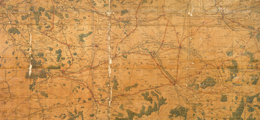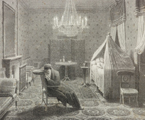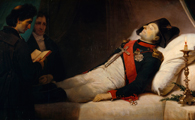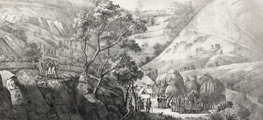1. The battle at St Helena
Living conditions at Longwood, exacerbated by the poor relations with the Governor, were terrible. The setting inspired ennui, the house and resources provided were deliberately threadbare, and the captivity caused disagreements amongst his entourage. Regardless, the Emperor had already decided aboard the Northumberland that he would fight for the only thing he had left.“I want to write about the great things we have done together!” he had said in 1814 to his faithful soldiers as he left for the island of Elba. On St Helena, with its ineluctable atmosphere of things falling apart, the past gradually took on a capital importance. The more the space closed in around him, the more time itself became for the Emperor a key battleground.
He organised his life like a military campaign. His entourage became his staff headquarters and imperial guard, and he worked them pitilessly. The British, with Governor Lowe at the head, became the enemy par excellence. Everyone, in one way or another, ended up writing their version of the story. History then became the last battlefield. How he would be remembered was to become the final victory.
2. The final hour
On St Helena, the Emperor was beaten, far from those he loved, reduced to passivity both by his jailers and his own behaviour. The good times, like those spent at The Briars with the Balcombes in 1815, were past. Occasional moments of enthusiasm drove him to write or garden energetically, but his morale and his health began failing rapidly after 1817.No longer having anything to do, he decided no longer to be.
For Great Britain, and the Governor under government orders, the responsibility for guarding Napoleon cut two ways. Firstly, it was a question of holding firm, preventing escape and any desire to return to the political stage. But it was also important to avoid exposing the country to the accusation of being responsible, even indirectly, for Napoleon’s death. The Emperor realised this dilemma and tried to take his revenge by writing in his will: “I die prematurely, assassinated by the English oligarchy and its assassin [Lowe]. The English nation will not be slow in avenging me.”
3. A bare tombstone in the sane valley
On the road from Jamestown, along the crater of the Devil’s Punch Bowl, sits a verdant valley. Napoleon discovered it on one of his excursions and particularly enjoyed the spring water there. It was here that he wished to be buried, well aware that he could not be buried on French soil. On 6 May, 1821, a tomb was dug in shade of two willow trees.After the autopsy, performed by Dr Antommarchi, the Emperor’s body was laid out in the bed chamber, which thereby became a chapel of rest. On 9 May, the funeral cortège left Longwood. The British gave Napoleon the honours due to a General. The Emperor’s body was laid to rest in four nesting coffins – one of tin, another of exotic wood, one of lead and a final coffin of teak.
The tomb was covered with three flag stones taken from the kitchen in New House. The French wanted to have the words “Napoléon. Né à Ajaccio le 15 août 1769, mort à Sainte-Hélène le 5 mai 1821”, (Napoleon. Born in Ajaccio on 15 August, 1769, died on St Helena, 5 May, 1821) inscribed on the stone, but the Governor wished to have the name Bonaparte added to this. No compromise was reached for this the last manifestation of the conflict that had characterised the exile. The tombstone was left bare.





